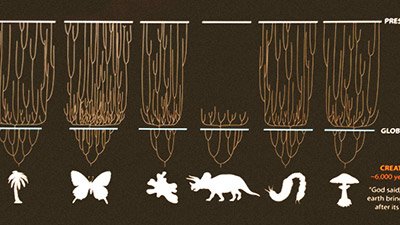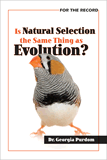
We Are the Champions (of Evolution)
“Mammals are special,” declares the leader of a new study on animal success rates. Just what does he mean?
News Source
- LiveScience: “Mammals Beat Reptiles in Battle of Evolution”
In a competition of evolutionary proportions, a study funded by the U.S. National Science Foundation has measured the biodiversity of species, declaring the more diverse species as “winners” and the less diverse as “losers.”
Led by evolutionary biologist Michael Alfaro of the University of California–Los Angeles, the scientists looked at DNA sequences and fossils from 47 major vertebrate groups, then calculated the “richness” (diversity) of each group. The assumption behind the study is that more diverse species have evolved more, diversifying to fit varying environments, while the “losers” have evolved, and thus diversified, less.
The winners of the diversity game include most mammals, most birds, and some fish. Crocodilians, on the other hand, ended up at the bottom of the heap, along with the lizard-like tuatara.
For the evolutionists, that’s a big surprise—in fact, the opposite of what one might initially suspect based on the evolutionary version of life’s history. After all, reptiles have had (supposedly) hundreds of millions of years to evolve and diversify, while mammals are said to be relative newcomers. Based on that old-earth model, Alfaro’s team claims that one group of mammals has diversified seven times faster than the scientists would have expected, while crocodiles and alligators have diversified 1,000 times more slowly than expected.
Similarly, modern birds have diversified nine times faster than expected; but the reptilian tuatara has yielded only two species “in the same period of time that produced more than 8,000 species of snakes and lizards,” Alfaro said. All of this is an evolutionary enigma, as Alfaro explained:
The timing of the rate increases does not correspond to the appearance of key characteristics that have been invoked to explain the evolutionary success of these groups, such as hair on mammals or mammals’ well-coordinated chewing ability or feathers on birds. Our results suggest that something more recent is the cause of the biodiversity. It may be that something more subtle explains the evolutionary success of mammals, birds and fish. We need to look for new explanations.
Evolution is re-interpreted—and “new explanations” are sought—to make the facts fit evolutionary theory.
Here’s one alternative explanation, though we doubt Alfaro has considered it. What if diversity is not, on the whole, an indicator of evolutionary success or time on the planet, but rather a factor of the created kinds God originally put on earth? That’s not to say that some kinds haven’t speciated more than other kinds; thus, there are some kinds that have been more “successful” than others.
In fact, if evolution were based on falsifiable hypotheses, this study would cast serious doubt on the evolution model. The longer a species has been around, the more diverse it should have become, based on average mutation rates and the like. But when scientists find that that isn’t the case, evolution is re-interpreted—and “new explanations” are sought—to make the facts fit evolutionary theory.
Additionally, we wonder if the low diversity of crocodilians and the tuatara may help explain why dinosaurs disappeared from the earth (as far as we know) some time after the Flood. While the fossil record shows a range of dinosaur types, it is possible that the dinosaur kinds on the Ark had poorer genetic diversity than, e.g., the mammal kinds on the Ark. Poorer genetic diversity could have restricted their ability to adapt to changing environments, and thus could have hastened their extinction.
While the complete history of life on earth is largely speculative (for both the creationist and the evolutionist), this latest study clearly contradicts evolutionary explanations, yet can easily be reconciled with the creation model of biology.
[One reader suggested an additional explanation of interest: the greater biological diversity of mammals and birds, and the lesser biological diversity of reptiles, could be due to the number of representatives of each kind Noah took on board the Ark. “You shall take with you seven each of every clean animal, a male and his female; two each of animals that are unclean, a male and his female; also seven each of birds of the air, male and female, to keep the species alive on the face of all the earth.” (Genesis 7:2–3)]
Further Reading
- Is Natural Selection the Same Thing as Evolution?
- Get Answers: Created Kinds (Baraminology), Genetics, Natural Selection, Speciation
For More Information: Get Answers
Remember, if you see a news story that might merit some attention, let us know about it! (Note: if the story originates from the Associated Press, FOX News, MSNBC, the New York Times, or another major national media outlet, we will most likely have already heard about it.) And thanks to all of our readers who have submitted great news tips to us. If you didn’t catch all the latest News to Know, why not take a look to see what you’ve missed?
(Please note that links will take you directly to the source. Answers in Genesis is not responsible for content on the websites to which we refer. For more information, please see our Privacy Policy.)
Recommended Resources

Answers in Genesis is an apologetics ministry, dedicated to helping Christians defend their faith and proclaim the good news of Jesus Christ.
- Customer Service 800.778.3390
- Available Monday–Friday | 9 AM–5 PM ET
- © 2025 Answers in Genesis



